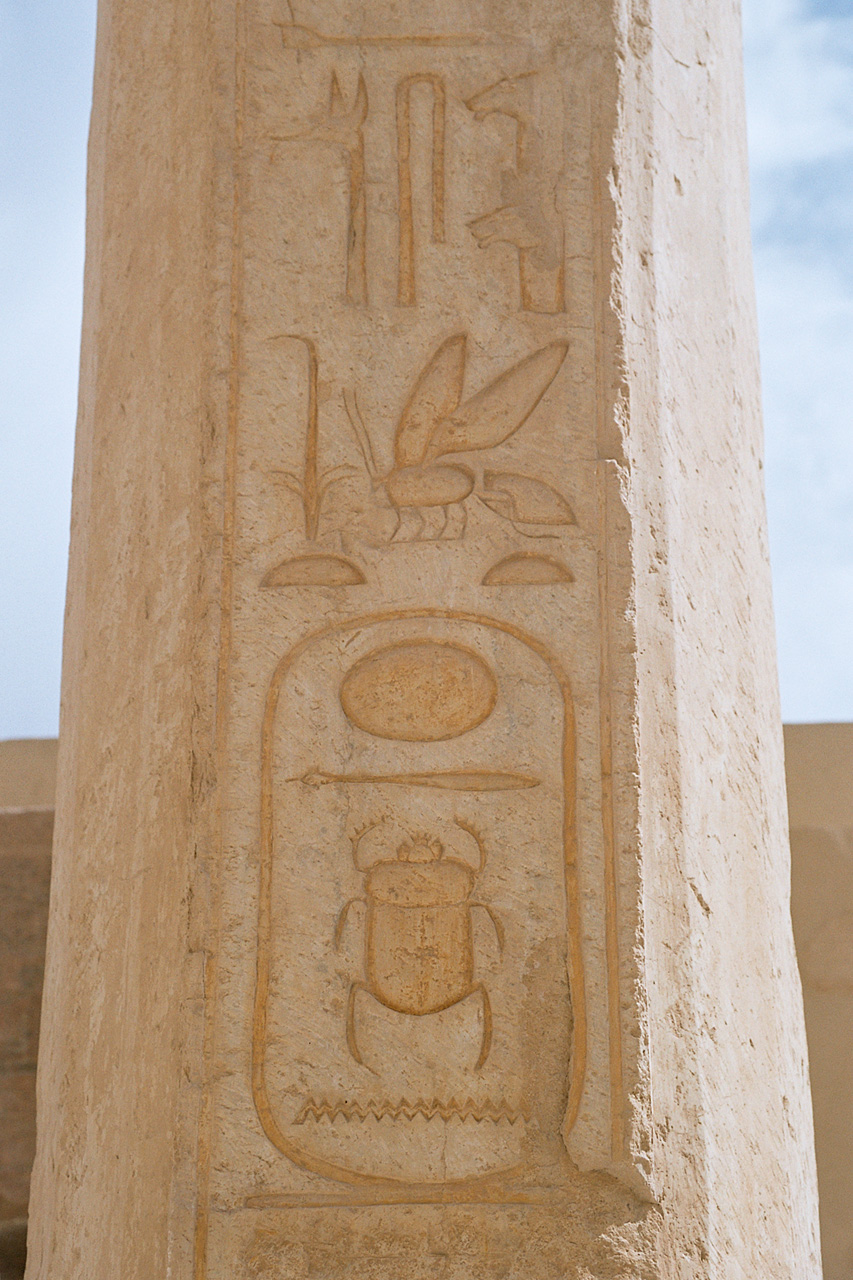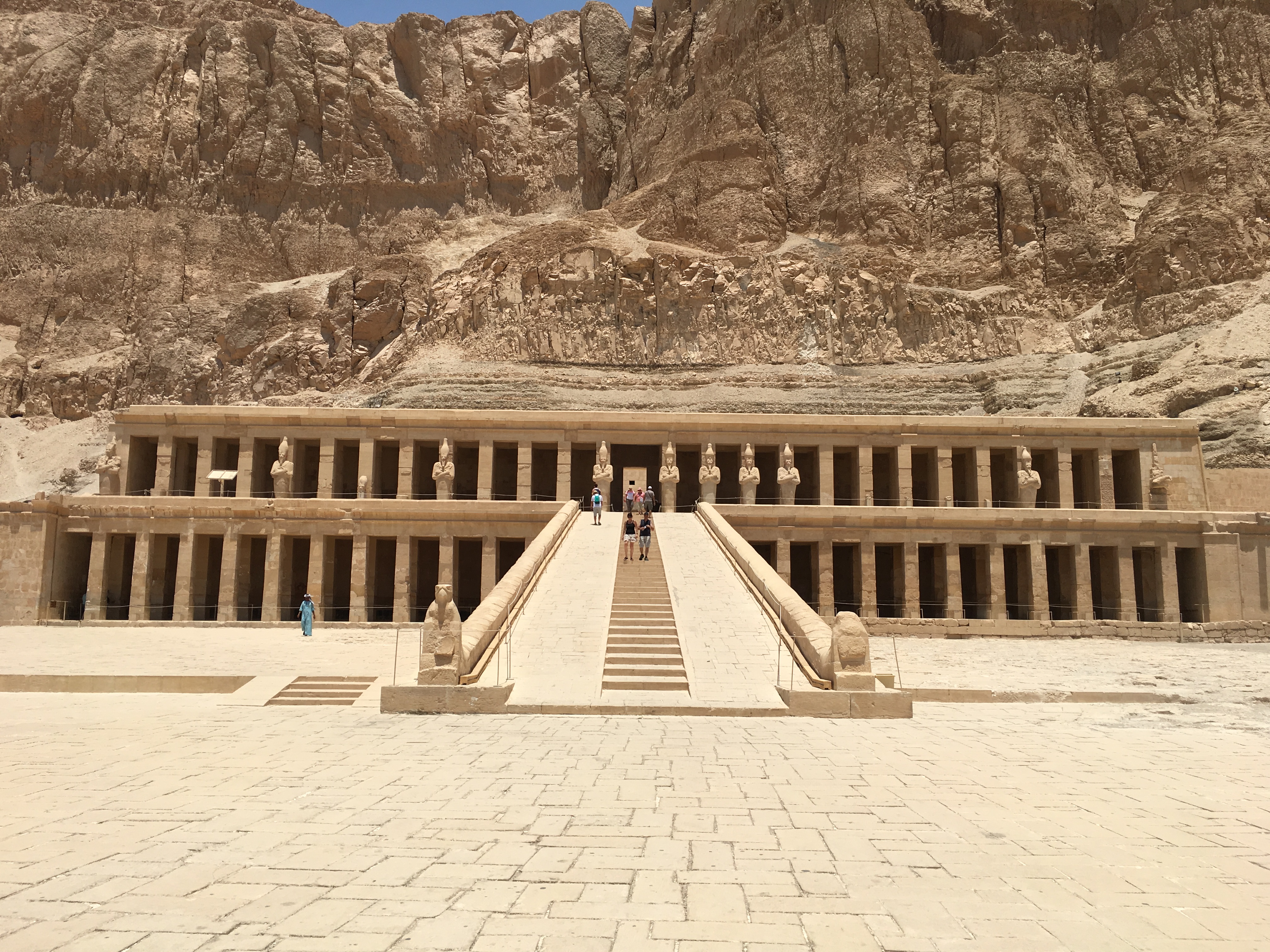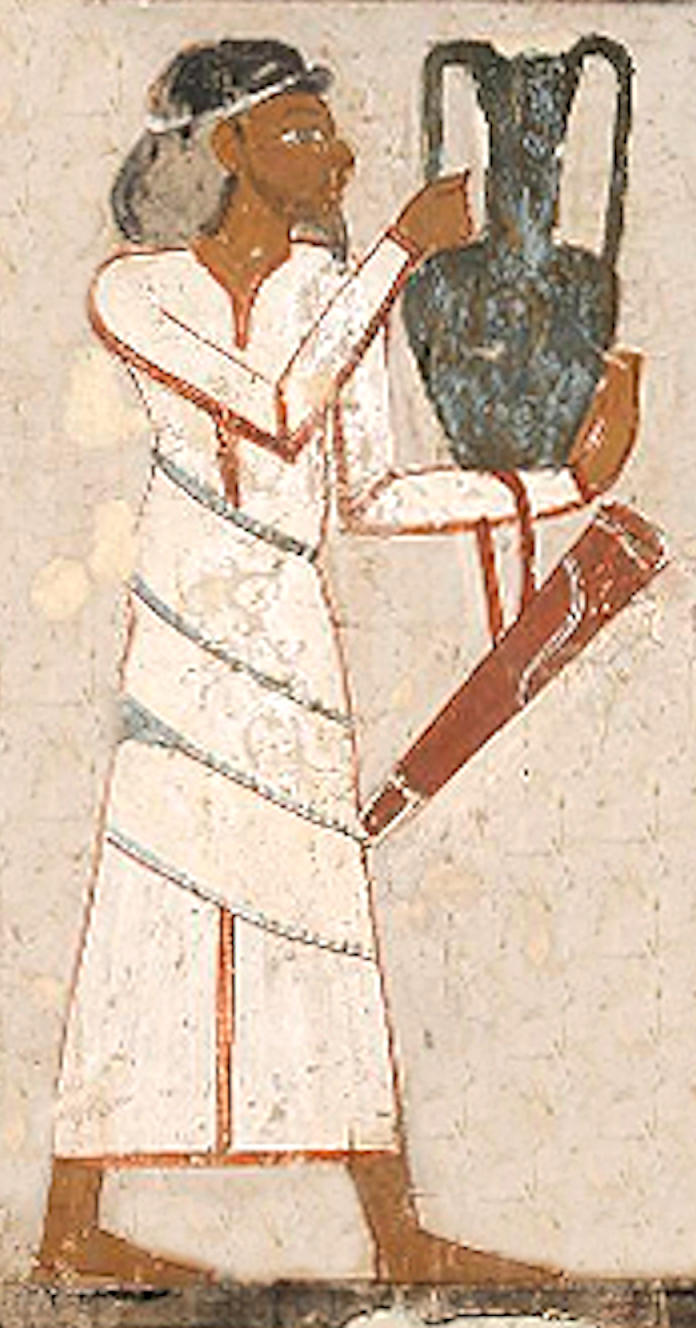|
Ineni
Ineni (sometimes transliterated as Anena) was an ancient Egyptian architect and government official of the 18th Dynasty, responsible for major construction projects under the pharaohs Amenhotep I, Thutmose I, Thutmose II and the joint reigns of Hatshepsut and Thutmose III. He had many titles, including Superintendent of the Granaries, Superintendent of the Royal Buildings, Superintendent of the Workmen in the Karnak Treasuries, etc. Ineni came from an aristocratic family and likely began his career as an architect under Amenhotep I. Amenhotep I commissioned Ineni to expand the Temple of Karnak. The expansion included a barque shrine of Amun and a new treasury. Ineni probably also oversaw the construction of Amenhotep I's tomb and mortuary temple. The mortuary temple was the first to be disconnected from the actual tomb, presumably so it would not draw attention to the burial site. Amenhotep I died before the treasury could be completed, but Ineni was retained by his successor, T ... [...More Info...] [...Related Items...] OR: [Wikipedia] [Google] [Baidu] |
TT81
The Theban Tomb TT81 is located in Sheikh Abd el-Qurna, part of the Theban Necropolis, on the west bank of the Nile, opposite to Luxor. It is the burial place of the ancient Egyptian official, Ineni and his family. Family Ineni is depicted in the tomb with his father who is also called Ineni and his mother Sitdjehuty. Ineni's wife is named Ahhotep and nicknamed Thuiu. A brother named Pahery in an inscription in the passage to the shrine. The shrine contains four statues depicting Ineni, his wife and his parents. Description Layout The tomb consists of a gallery cut into the rock, the roof of which is supported by six square pillars. From this gallery leads a chamber, at the end of which is a shrine which contains a group of four statues. Decoration The tomb of Ineni as part of an earlier group of tombs from the time of Tuthmosis III, which were decorated using a blue background color. This may be an imitation of nearby color schemes of tombs from the Middle Kingdom. The tom ... [...More Info...] [...Related Items...] OR: [Wikipedia] [Google] [Baidu] |
Ineni005
Ineni (sometimes transliterated as Anena) was an ancient Egyptian architect and government official of the 18th Dynasty, responsible for major construction projects under the pharaohs Amenhotep I, Thutmose I, Thutmose II and the joint reigns of Hatshepsut and Thutmose III. He had many titles, including Superintendent of the Granaries, Superintendent of the Royal Buildings, Superintendent of the Workmen in the Karnak Treasuries, etc. Ineni came from an aristocratic family and likely began his career as an architect under Amenhotep I. Amenhotep I commissioned Ineni to expand the Temple of Karnak. The expansion included a barque shrine of Amun and a new treasury. Ineni probably also oversaw the construction of Amenhotep I's tomb and mortuary temple. The mortuary temple was the first to be disconnected from the actual tomb, presumably so it would not draw attention to the burial site. Amenhotep I died before the treasury could be completed, but Ineni was retained by his successor, T ... [...More Info...] [...Related Items...] OR: [Wikipedia] [Google] [Baidu] |
Amenhotep I
Amenhotep I () ( egy, wikt:jmn-ḥtp, jmn-ḥtp(w) /jaˌmanuwˈħatpaw/ "Amun is satisfied"; Amarna cuneiform ''a-ma-an-ha-at-pe'' or ''-at-pa''), Amenôthes I, or Amenophis I, (,) from Ancient Greek Ἀμένωφις ,Dodson & Hilton (2004) p.126 additionally ''King Djeserkare'' (transliteration: ''Ḏsr-k3-R`''), was the second Pharaoh of the Eighteenth Dynasty of Egypt, 18th Dynasty of History of Ancient Egypt, Egypt. His reign is #Dates and length of reign, generally dated from 1526 to 1506 BC. He was a son of Ahmose I and Ahmose-Nefertari, but had at least two elder brothers, Ahmose-ankh and Ahmose Sapair, and was not expected to Enthronement, inherit the throne. However, sometime in the eight years between Ahmose I's 17th regnal year and his death, his heir apparent died and Amenhotep became crown prince. He then acceded to the throne and ruled for about 21 years.Manetho - translated by W.G. Waddell, Loeb Classical Library, 1940, p.109 Although his reign is poorly documented ... [...More Info...] [...Related Items...] OR: [Wikipedia] [Google] [Baidu] |
Thutmose I Of Egypt
Thutmose I (sometimes read as Thutmosis or Tuthmosis I, Thothmes in older history works in Latinized Greek; Ancient Egyptian: '' ḏḥwtj- ms'', ''Tʼaḥawtī-mīsaw'', , meaning "Thoth is born") was the third pharaoh of the 18th Dynasty of Egypt. He received the throne after the death of the previous king, Amenhotep I. During his reign, he campaigned deep into the Levant and Nubia, pushing the borders of Egypt farther than ever before in each region. He also built many temples in Egypt, and a tomb for himself in the Valley of the Kings; he is the first king confirmed to have done this (though Amenhotep I may have preceded him). Thutmose I's reign is generally dated to 1506–1493 BC, but a minority of scholars—who think that astrological observations used to calculate the timeline of ancient Egyptian records, and thus the reign of Thutmose I, were taken from the city of Memphis rather than from Thebes—would date his reign to 1526–1513 BC. He was succeeded by his son T ... [...More Info...] [...Related Items...] OR: [Wikipedia] [Google] [Baidu] |
Thutmose II Of Egypt
Thutmose II (sometimes read as Thutmosis or Tuthmosis II, Thothmes in older history works in Latinized Greek; Ancient Egyptian: /''ḏḥwty.ms''/ ''Djehutymes'', meaning "Thoth is born") was the fourth Pharaoh of the Eighteenth Dynasty of Egypt. His reign is generally dated from 1493 to 1479 BC. His body was found in the Deir el-Bahri Cache above the Mortuary Temple of Hatshepsut and can be viewed today in the National Museum of Egyptian Civilization in Cairo. Family Thutmose II was the son of Thutmose I and a minor wife, Mutnofret. He was, therefore, a lesser son of Thutmose I and chose to marry his fully royal half-sister, Hatshepsut, in order to secure his kingship. While he successfully put down rebellions in Nubia and the Levant and defeated a group of nomadic Bedouins, these campaigns were specifically carried out by the king's Generals, and not by Thutmose II himself. This is often interpreted as evidence that Thutmose II was still a minor at his accession. Th ... [...More Info...] [...Related Items...] OR: [Wikipedia] [Google] [Baidu] |
Valley Of The Kings
The Valley of the Kings ( ar, وادي الملوك ; Late Coptic: ), also known as the Valley of the Gates of the Kings ( ar, وادي أبوا الملوك ), is a valley in Egypt where, for a period of nearly 500 years from the 16th to 11th century BC, rock-cut tombs were excavated for the pharaohs and powerful nobles of the New Kingdom (the Eighteenth to the Twentieth Dynasties of Ancient Egypt). The valley stands on the west bank of the Nile opposite Thebes (modern Luxor), within the heart of the Theban Necropolis.Siliotti (1997), p.13 The wadi consists of two valleys: the East Valley (where the majority of the royal tombs are situated) and the West Valley (Valley of the Monkeys). With the 2005 discovery of a new chamber and the 2008 discovery of two further tomb entrances, the valley is known to contain 63 tombs and chambers (ranging in size from KV54, a simple pit, to KV5, a complex tomb with over 120 chambers). It was the principal burial place of the major roy ... [...More Info...] [...Related Items...] OR: [Wikipedia] [Google] [Baidu] |
Hatshepsut Of Egypt
Hatshepsut (; also Hatchepsut; Egyptian: '' ḥꜣt- špswt'' "Foremost of Noble Ladies"; or Hatasu c. 1507–1458 BC) was the fifth pharaoh of the Eighteenth Dynasty of Egypt. She was the second historically confirmed female pharaoh, after Sobekneferu. (Various other women may have also ruled as pharaohs or at least regents before Hatshepsut, as early as Neithhotep around 1,600 years prior.) Hatshepsut came to the throne of Egypt in 1478 BC. As the principal wife of Thutmose II, Hatshepsut initially ruled as regent to Thutmose III, a son of Thutmose II by another wife and the first male heir. While Thutmose III had inherited the throne at about two years old, Hatshepsut continued to rule by asserting her lineage as the daughter and only child of Thutmose I and his primary wife, Ahmose. Her husband Thutmose II was the son of Thutmose I and a secondary wife named Mutnofret, who carried the title 'King's daughter' and was probably a child of Ahmose I. Hatshepsut and ... [...More Info...] [...Related Items...] OR: [Wikipedia] [Google] [Baidu] |
13th Dynasty
In music or music theory, a thirteenth is the Musical note, note thirteen scale degrees from the root (chord), root of a chord (music), chord and also the interval (music), interval between the root and the thirteenth. The interval can be also described as a Interval (music)#Simple and compound, compound major sixth, sixth, spanning an octave plus a sixth. The thirteenth is most commonly major or minor . A thirteenth chord is the stacking of six (major third, major or minor third, minor) thirds, the last being above the 11th of an eleventh chord. Thus a thirteenth chord is a tertian (built from thirds) chord containing the interval of a thirteenth, and is an extended chord if it includes the ninth and/or the eleventh. "The jazzy thirteenth is a very versatile chord and is used in many genres." Since 13th chords tend to become unclear or confused with other chords when Inverted chord, inverted, they are generally found in root position.Benward & Saker (2009). ''Music in ... [...More Info...] [...Related Items...] OR: [Wikipedia] [Google] [Baidu] |
Stela
A stele ( ),Anglicized plural steles ( ); Greek plural stelai ( ), from Greek , ''stēlē''. The Greek plural is written , ''stēlai'', but this is only rarely encountered in English. or occasionally stela (plural ''stelas'' or ''stelæ''), when derived from Latin, is a stone or wooden slab, generally taller than it is wide, erected in the ancient world as a monument. The surface of the stele often has text, ornamentation, or both. These may be inscribed, carved in relief, or painted. Stelae were created for many reasons. Grave stelae were used for funerary or commemorative purposes. Stelae as slabs of stone would also be used as ancient Greek and Roman government notices or as boundary markers to mark borders or property lines. Stelae were occasionally erected as memorials to battles. For example, along with other memorials, there are more than half-a-dozen steles erected on the battlefield of Waterloo at the locations of notable actions by participants in battle. A ... [...More Info...] [...Related Items...] OR: [Wikipedia] [Google] [Baidu] |
Deir El-Bahri
Deir el-Bahari or Dayr al-Bahri ( ar, الدير البحري, al-Dayr al-Baḥrī, the Monastery of the North) is a complex of mortuary temples and tombs located on the west bank of the Nile, opposite the city of Luxor, Egypt. This is a part of the Theban Necropolis. The first monument built at the site was the mortuary temple of Mentuhotep II of the Eleventh Dynasty. It was constructed during the 21st century BC. During the Eighteenth Dynasty, Amenhotep I and Hatshepsut also built extensively at the site. Mortuary temple of Nebhepetre Mentuhotep Mentuhotep II, the Eleventh Dynasty king who reunited Egypt at the beginning of the Middle Kingdom, built a very unusual funerary complex. His mortuary temple was built on several levels in the great bay at Deir el-Bahari. It was approached by a 16-metre-wide (50-ft) causeway leading from a valley temple which no longer exists. The mortuary temple itself consists of a forecourt and entrance gate, enclosed by walls on three sides, a ... [...More Info...] [...Related Items...] OR: [Wikipedia] [Google] [Baidu] |
Senemut
Senenmut ( egy, sn-n-mwt, sometimes spelled Senmut, Senemut, or Senmout) was an 18th Dynasty ancient Egyptian architect and government official. His name translates literally as "mother's brother." Family Senenmut was of low commoner birth, born to literate provincial parents, Ramose and Hatnofer (or "Hatnefret") from Iuny (modern Armant). Senenmut is known to have had three brothers (Amenemhet, Minhotep, and Pairy) and two sisters (Ahhotep and Nofrethor). However, only Minhotep is named outside chapel TT71 and tomb TT353, in an inventory on the lid of a chest found in the burial chamber of Ramose and Hatnofer. More information is known about Senenmut than many other non-royal Egyptians because the joint tomb of his parents (the construction of which Senenmut supervised himself) was discovered intact by the Metropolitan Museum in the mid-1930s and preserved. Christine Meyer has offered compelling evidence to show that Senenmut was a bachelor for his entire life: for instanc ... [...More Info...] [...Related Items...] OR: [Wikipedia] [Google] [Baidu] |
Hyksos
Hyksos (; Egyptian '' ḥqꜣ(w)- ḫꜣswt'', Egyptological pronunciation: ''hekau khasut'', "ruler(s) of foreign lands") is a term which, in modern Egyptology, designates the kings of the Fifteenth Dynasty of Egypt (fl. c. 1650–1550 BC). The seat of power of these kings was the city of Avaris in the Nile delta, from where they ruled over Lower and Middle Egypt up to Cusae. In the ''Aegyptiaca'', a history of Egypt written by the Greco-Egyptian priest and historian Manetho in the 3rd century BC, the term Hyksos is used ethnically to designate people of probable West Semitic, Levantine origin. While Manetho portrayed the Hyksos as invaders and oppressors, this interpretation is questioned in modern Egyptology. Instead, Hyksos rule might have been preceded by groups of Canaanite peoples who gradually settled in the Nile delta from the end of the Twelfth Dynasty onwards and who may have seceded from the crumbling and unstable Egyptian control at some point during the ... [...More Info...] [...Related Items...] OR: [Wikipedia] [Google] [Baidu] |





